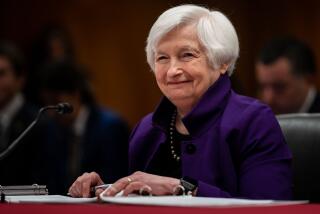FHLBB Warns of Cash-Shortage ‘Crisis’ : Worries That Regional Banks May Refuse Loans to Ailing S
- Share via
WASHINGTON — The Federal Home Loan Bank Board is worried that the 12 regional Federal Home Loan banks soon will refuse to lend money to the sickest U.S. savings and loan institutions, the bank board and the U.S. Treasury have told Congress.
A refusal to make new loans could leave 272 ailing S&Ls--which; are losing $6 million a day--without enough cash to meet day-to-day expenses, according to a Nov. 26 memo made available Tuesday. The memo was written to congressional banking committees by the bank board, which is the federal agency that regulates S&Ls; and oversees the 12 regional banks.
The resulting cash shortage could trigger a “crisis” by further eroding public confidence in the troubled $1-trillion savings and loan industry, federal officials said Tuesday. Though chartered by Congress to raise funds for the S&L; industry, the regional banks have considerable autonomy in managing their banking operations.
The Federal Home Loan Bank of San Francisco recently refused to make loans to two ailing S&Ls; and instead advised the struggling institutions “to more aggressively solicit new deposits,” according to a second memo, dated Nov. 24 and written by James Meyer, a bank board official who oversees 50 of the troubled S&Ls; now managed by the federal government.
The other regional banks have said that they too might refuse new loans, congressional and Administration officials said. The banks are worried that the bank board, which insures loans to ailing S&Ls;, may not have enough money in its deposit insurance fund to cover the borrowings if the S&Ls; cannot repay them, the officials said.
A spokesman for the Federal Home Loan Bank of San Francisco said the bank continues to make loans to ailing S&Ls;, as long as the borrowings are backed by the Federal Savings and Loan Insurance Corp. The statement contradicts what Meyer and other officials at the bank board and in Congress say the banks are saying privately.
Congress is considering, among other things, a White House plan to raise $25 billion for the fund over five years, including $15 billion raised from bonds and $10 billion raised by charging higher fees to the S&L; industry.
The U.S. League of Savings Institutions has opposed the White House plan. Tuesday, it proposed a two-year plan that would require far less money from the industry.
More to Read
Inside the business of entertainment
The Wide Shot brings you news, analysis and insights on everything from streaming wars to production — and what it all means for the future.
You may occasionally receive promotional content from the Los Angeles Times.










